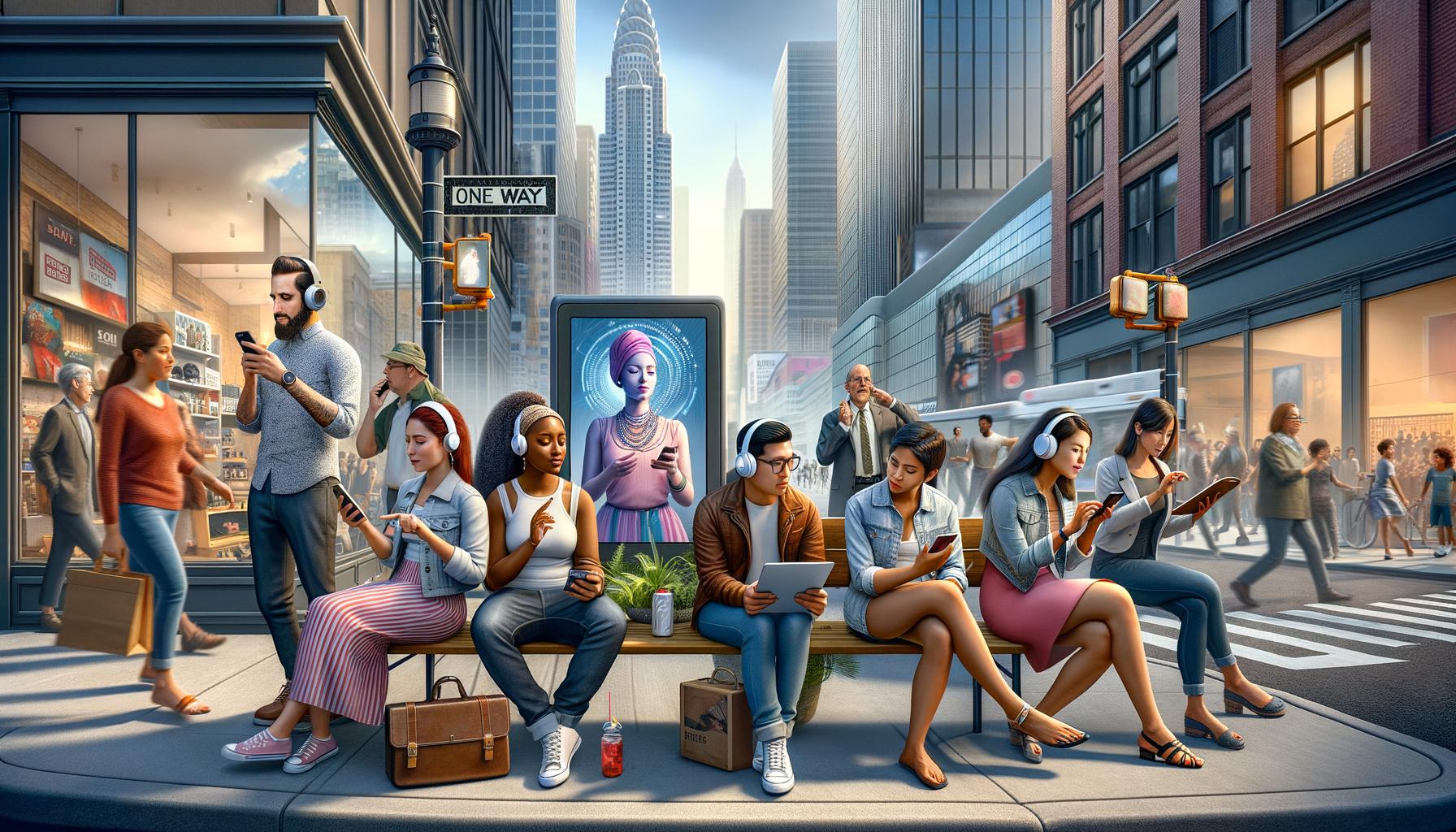At Beverly Hills Publishing, we’re excited to explore the dynamic world of new media.
The new media definition encompasses a wide range of digital technologies that have revolutionized how we communicate, consume information, and interact with the world around us.
In this blog post, we’ll examine the characteristics of new media, its impact on society, and the challenges and opportunities it presents in our increasingly connected world.
What Defines New Media?
The Digital Revolution
New media has transformed communication, information consumption, and global interaction. It refers to digital technologies and platforms that enable interactive, real-time communication and content creation.

New media’s digital nature distinguishes it from traditional media like print newspapers or analog television. This digital foundation allows instant transmission, easy replication, and widespread accessibility of content.
Interactivity stands as one of the most significant aspects of new media. New media technologies influence people’s behavior, enabling them to interact online and create content. Social media platforms (such as Facebook and Twitter) exemplify this shift, allowing users to share, comment, and engage with content in real-time.
The Shift from Traditional to New Media
Traditional media follows a one-to-many model of communication, while new media enables many-to-many interactions. This shift has profound implications for information spread and human connection.
Traditional media (like television and radio) often requires significant resources and infrastructure for content production and distribution. In contrast, new media platforms have lowered the barriers to entry for content creation. Anyone with a smartphone and internet connection can now become a content creator, potentially reaching global audiences.
Information dissemination speed marks another key difference. While a newspaper might take hours or days to report an event, social media platforms can spread news almost instantaneously. This rapid information flow has altered how we consume news and stay informed about world events.
Technologies Shaping the New Media Landscape
Several key technologies drive the evolution of new media:
- Smartphones: The widespread adoption of these devices has put powerful computing capabilities in the pockets of billions worldwide. Statista projects the number of smartphone users globally to reach 4.5 billion by 2024.
- High-speed internet connectivity: Including 5G networks, this technology allows seamless streaming of high-quality video content, real-time video calls, and immersive virtual reality experiences.
- Artificial Intelligence (AI) and machine learning: These technologies play a significant role in content personalization. They analyze user behavior and preferences to deliver tailored content recommendations, enhancing user engagement and retention.
- Cloud computing: This innovation allows new ways of creating, managing, and broadcasting media content more effectively. It enables seamless synchronization of content across devices and provides on-demand access to vast libraries of media content.
The Impact on Publishing
The digital nature of new media opens up exciting possibilities for the publishing industry. It allows for interactive storytelling, multimedia content creation, and direct engagement with readers. Publishers (like Beverly Hills Publishing™) can leverage these technologies to connect authors with their audiences in innovative ways, enhancing the reading experience and expanding the reach of their work.
As we move forward, the lines between different forms of media continue to blur. The integration of text, audio, video, and interactive elements creates rich, immersive experiences that challenge traditional definitions of content. This convergence of media forms represents the next frontier in the evolution of new media, promising even more engaging and dynamic ways to communicate and share information.
How Is New Media Reshaping Society?
A New Era of Communication
New media has fundamentally altered the fabric of our society, transforming how we communicate, conduct business, learn, and engage in political discourse. These changes have far-reaching implications for individuals, organizations, and society as a whole.

The rise of social media platforms has revolutionized personal communication. A 2021 Pew Research Center study revealed that a majority of Americans say they use YouTube and Facebook, while use of Instagram, Snapchat and TikTok is especially common among adults under 30. This shift has led to more frequent, but often shorter and more casual interactions. Emojis, GIFs, and memes have become a language of their own, allowing for quick emotional expression.
However, this new communication landscape also presents challenges. The constant connectivity can lead to information overload and decreased attention spans.
Transforming Business and Marketing
New media has dramatically altered the business landscape, particularly in marketing and customer engagement. Ad spending in the Social Media Advertising market is projected to reach US$79.7bn in 2025 in the United States.
Companies now have direct channels to communicate with their customers, gather feedback, and provide real-time customer service. Many businesses use chatbots on their websites and social media platforms to provide 24/7 customer support.
Influencer marketing has emerged as a powerful tool.
Revolutionizing Education and Learning
The education sector has experienced profound impacts from new media. Online learning platforms like Coursera and edX have made education more accessible.
Virtual and augmented reality technologies enhance learning experiences. Medical students can now practice complex procedures in virtual environments before performing them on real patients.
However, the digital divide remains a significant challenge.
New Frontiers in Political Discourse
New media has reshaped political engagement and activism. Social media platforms have become essential for political campaigns and public discourse.
However, these platforms have also facilitated the spread of misinformation.
Grassroots movements have gained unprecedented momentum through social media. The #MeToo movement (which began on Twitter) led to significant societal changes and sparked global conversations about sexual harassment and assault.
As we continue to explore the impact of new media on society, we must also consider the challenges and opportunities it presents. The next section will examine these aspects in detail, providing insights into how we can navigate this ever-evolving digital communication landscape.
Navigating New Media Challenges
Bridging the Digital Divide
The digital divide presents a significant challenge in the new media landscape. Approximately 67% of the world’s population is using the Internet in 2023, according to the International Telecommunication Union. This gap limits access to information and hinders economic opportunities and social participation.

Governments and tech companies implement various initiatives to address this issue. Google’s Project Loon uses high-altitude balloons to provide internet access to remote areas. SpaceX’s Starlink aims to offer global broadband coverage through a constellation of satellites.
Authors and publishers can contribute to bridging this divide. They should create content in multiple formats, including text, audio, and video, to cater to diverse audience preferences and technological capabilities.
Safeguarding Privacy and Security
New media platforms collect vast amounts of user data, which raises privacy and security concerns. The Cambridge Analytica scandal highlighted the potential for data misuse, affecting millions of Facebook users.
The European Union implemented the General Data Protection Regulation (GDPR) in 2018 to protect user privacy. This regulation set a new standard for data protection laws worldwide. In the United States, the California Consumer Privacy Act (CCPA) provides similar protections for California residents.
Content creators and publishers must prioritize user privacy and data security. They should implement robust data protection measures, be transparent about data collection practices, and provide users with control over their personal information. These steps are essential to build trust with the audience.
Mastering Content Creation and Curation
Creating compelling content that stands out is more challenging than ever in the age of information overload. WordPress users produce about 70 million new posts each month. To cut through the noise, content creators must focus on quality, relevance, and audience engagement.
Data-driven content strategies can significantly improve content performance. Tools like Google Analytics and social media insights provide valuable data on audience preferences and behavior. BuzzSumo’s analysis of 100 million articles found that long-form content (3,000-10,000 words) receives more social shares than shorter articles.
We at Beverly Hills Publishing™ emphasize the importance of creating high-quality, authoritative content that provides real value to readers. This approach enhances an author’s credibility and improves visibility in search engine results.
Developing Effective Monetization Strategies
Monetizing content in the digital age requires innovative approaches. Traditional advertising models are evolving. Programmatic advertising will account for 88% of all digital display ad spending in the U.S. by 2022 (according to eMarketer).
Subscription models have gained traction. The New York Times reported over 7 million digital-only subscribers in 2021. For individual content creators, platforms like Patreon enable direct financial support from fans. Top creators on Patreon earn over $1 million annually.
E-commerce integration offers another revenue stream. Instagram’s shopping features allow creators to tag products in posts, facilitating direct purchases. This approach has proven particularly effective in the fashion and beauty industries.
Digital publishing opens up new monetization avenues for authors. E-books, audiobooks, and online courses can complement traditional print sales. Moreover, authors can establish themselves as industry authorities through strategic content creation. This can lead to speaking engagements, consulting opportunities, and brand partnerships.
Final Thoughts
New media has transformed communication, information consumption, and global interaction. The new media definition encompasses digital technologies that enable interactive, real-time content creation and sharing. These technologies have reshaped society, influencing business, education, and political discourse in profound ways.

As we look to the future, emerging technologies will likely drive the next wave of innovation in the new media landscape. However, challenges such as the digital divide, privacy concerns, and misinformation spread will require ongoing attention. Organizations and individuals must adapt to this evolving environment to thrive.
At Beverly Hills Publishing, we recognize the importance of navigating this new media environment. We help authors leverage digital platforms to build their brand and reach wider audiences. The future of communication is digital and interactive, offering exciting opportunities for those who embrace its potential.







